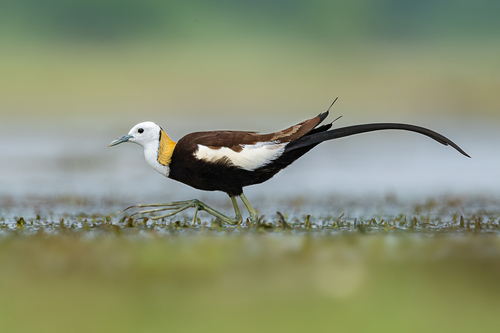
Pheasant-tailed Jacana
The pheasant-tailed jacana dazzles with its ornate plumage and nimble leaf-walking skills, making it a spectacle in Asian wetlands. Its unique polyandrous lifestyle and tail extensions set it apart, playing a crucial role in aquatic ecosystems by controlling insect populations.
4.8 years
Lifespan
113.4 - 198.4 g
Weight
Length: 43 - 56 cm
Size
Brown, Black, White, Gold
Color
2 years
Age of Sexual Maturity
Least Concern
Conservation Status
Decreasing
Population Trend
Characteristics
Hydrophasianus chirurgus, commonly known as the pheasant-tailed jacana, is recognized for its striking breeding plumage with elongated tail feathers. It thrives in freshwater wetlands across South Asia and Southeast Asia. Notably, this species demonstrates polyandrous behavior and has remarkable floating leaf-walking skills thanks to its long toes.
Distribution Range of the Pheasant-tailed Jacana
The Pheasant-tailed Jacana (Hydrophasianus chirurgus) is native to South and Southeast Asia. Its geographical distribution includes countries such as India, Pakistan, Nepal, Bangladesh, Sri Lanka, Myanmar, Thailand, Vietnam, Laos, Cambodia, and parts of southern China. The species is also found in Indonesia and the Philippines during certain seasons.
Pheasant-tailed Jacana's Habitat
Environmental Conditions
The Pheasant-tailed Jacana primarily inhabits freshwater wetlands, including ponds, lakes, marshes, and rice paddies. These environments typically have abundant floating vegetation, such as water lilies and other aquatic plants, which provide essential cover and foraging grounds. The climate in these regions ranges from tropical to subtropical, with seasonal variations in rainfall and temperature.
Ecological Niche
Hydrophasianus chirurgus occupies an ecological niche as a wader and surface feeder in freshwater ecosystems. It is well adapted to walking on floating vegetation due to its long toes and claws. The species primarily feeds on insects, invertebrates, and occasionally seeds found on or near the water surface. During the breeding season, it is known for its polyandrous behavior, where females mate with multiple males, each of which incubates the eggs and cares for the young.
Copyright @ Nature Style Limited. All Rights Reserved.
 English
English